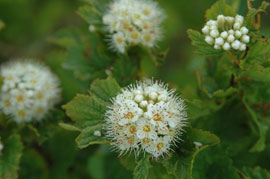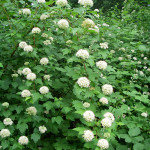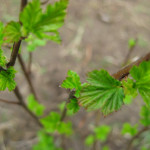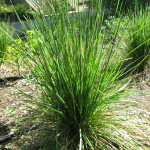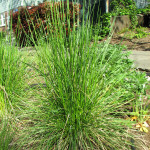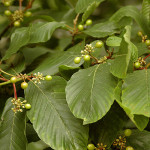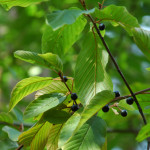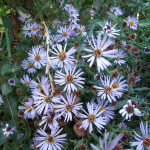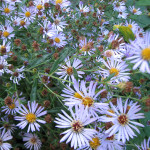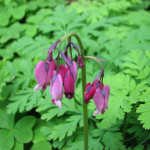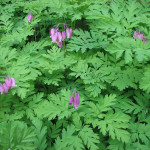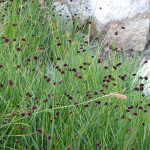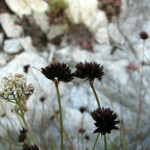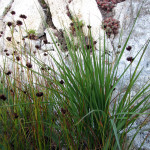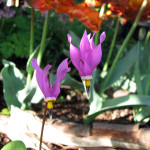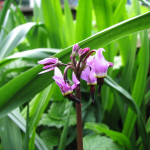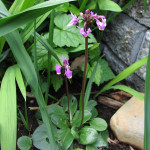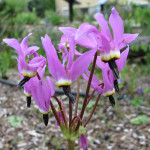Physocarpus capitatus
Pacific ninebark (Physocarpus capitatus) is a dense deciduous shrub growing up to 12 feet tall. The name refers to the unusual bark, which naturally peels off in many colorful layers.
The shrub has maple-like lobed leaves and attractive clusters of small white flowers in May and June. The unique fruit is a glossy red pod which turns dry and brown, and then splits open to release seeds.
The twigs, berries, buds, and leaves are all browsed by wildlife. Pacific ninebark is very important for pollinators, especially solitary bees who lay their eggs and take shelter for the winter in the hollow stems. Pacific ninebark is also a food source for the young of spring azure butterflies, and many birds use it for nesting.
It is often found in wetlands, but also forms thickets along rivers and in moist forest habitats. It can also tolerate some drought. Create a dense deciduous screen by growing it in combination with oceanspray and Douglas spirea. Best in full sun to part shade.
- Light Requirements: Part Shade
- Water Requirements: Moist, Seasonally Wet
- Ease of Growing: Easy to grow
- Growth Rate: Fast
- Spreads: Yes
- Wildlife Support: Pollinators, Pest-eating Insects, Birds or Mammals
- Fire-resistant: Yes
- Edible: No
- Mature Height: 8-12ft
- Mature Width:4-7ft
Tufted Hairgrass
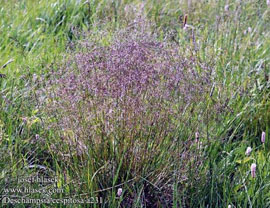
Deschampsia cespitosa
Tufted Hairgrass is found around the world including the eastern and western coasts of North America, parts of South America, and Eurasia. It is a native, perennial, tussock forming grass found along stream banks and in moist meadows, fields, wet ditches and open areas surrounding lakes and ponds. Tufted hairgrass is a large densely tufted, course, long lived, perennial bunch grass. It has bright green foliage and a large volume of fountain-like seed culms emerging in early spring, making it highly aesthetic. Tufted hairgrass prefer open sites. This grass is rarely, if ever an under story species of temperate forest communities (Brown et al. 1988).
In the Pacific Northwest tufted hairgrass form pure stands in wet and intermittently flooded areas such as tidal mudflats and estuaries plant communities. It grows in seeps bogs, and brackish waters along the coastal waterways. It is very salt tolerant grass and, as a result, is commonly included in many restoration or re-vegetation projects where brackish water exists.
Tufted hairgrass is also a rapid colonizer of disturbed sites at high elevations (8,000 ft – Cascade & Sierra Range). Such characteristics make it valuable for reclamation of disturbed high elevation mines, ski slopes and high elevation meadows. Tufted hairgrass, unlike blue wildrye, is genetically heterogeneous, self-incompatible and requires wind and insect pollinators for effective fertilization. Tufted hairgrass should be included in wetland, restoration projects since it provides very dense nesting foliage and has a very long summer green period. It is also a valuable stream bank erosion plant where long-term stabilization is necessary, and should be established with a nurse crop (blue wildrye, meadow barley, California brome, Alaska brome) or native straw mulch for superior first year establishment.
- Light Requirements: Full Sun
- Water Requirements: Dry, Moist, Seasonally Wet
- Ease of Growing: Easy to grow
- Growth Rate: Fast
- Spreads:
- Wildlife Support: Birds or Mammals
- Fire-resistant: No
- Edible: No
- Mature Height: 2-3ft
- Mature Width:1-2ft
Cascara

Frangula purshiana
Cascara (Frangula purshiana) is found along the Pacific coast from British Columbia to northern California along riverbanks and in other moist locations.
A hardy, compact, attractive tree, it is often planted in Portland’s parking strips. In the spring it produces clusters of small, green-white flowers. In late autumn, the leaves turn a delicate yellow and persist through many a winter storm.
The flowers attract many pollinators in early summer such as Lorquin’s admiral butterflies. Pale swallowtail butterflies lay their eggs on the leaves. Birds enjoy the fruit, but they are toxic to humans and should be avoided.
- Light Requirements: Part Shade, Full Shade
- Water Requirements: Moist, Seasonally Wet
- Ease of Growing: Easy to grow
- Growth Rate: Slow
- Spreads: No
- Wildlife Support: Pollinators, Birds or Mammals
- Fire-resistant: Yes
- Edible: No
- Mature Height: 30ft
- Mature Width:20ft
Star-flowered Solomon’s Seal
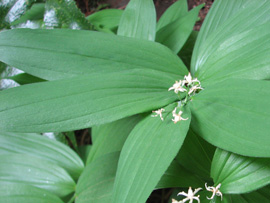
Maianthemum stellatum
Beautiful blue-green foliage, white flowers spring through summer, and red and white striped berries. Great for woodland gardens.
- Light Requirements: Part Shade, Full Shade
- Water Requirements: Moist
- Ease of Growing: Easy to grow
- Growth Rate: Moderate
- Spreads:
- Wildlife Support: Pest-eating Insects, Birds or Mammals
- Fire-resistant: No
- Edible:
- Mature Height: 1-2ft
- Mature Width:1ft
Douglas Aster

Aster subspicatus
Douglas Aster is a tall spreading perennial that blooms into the late summer and thrives on saltwater shorelines. The rather lanky stems are topped with bluish purple flowers that look like miniature daisies (ray flowers). The prolific blooms will draw lots of butterflies.
- Light Requirements: Full Sun
- Water Requirements: Moist
- Ease of Growing: Easy to grow
- Growth Rate: Fast
- Spreads: Yes
- Wildlife Support: Pollinators, Hummingbirds, Pest-eating Insects, Birds or Mammals
- Fire-resistant: No
- Edible:
- Mature Height: 1-4ft
- Mature Width:2ft
Western Bleeding Heart
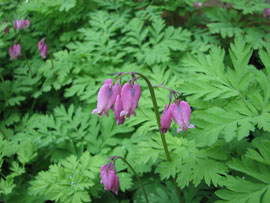
Dicentra formosa ssp. formosa
Bleeding heart’s showy flower resembles a heart split open at the base, releasing its contents. It has delicate-looking fernlike leaves, with pink flowers that bloom from April to June. Bleeding heart prefers rich soil and some shade. It will thrive planted under evergreen trees or along stream banks. Heights of 26 inches can be reached though 12-16″ is more common.
- Light Requirements: Part Shade, Full Shade
- Water Requirements: Moist
- Ease of Growing: Easy to grow
- Growth Rate: Moderate
- Spreads:
- Wildlife Support: Hummingbirds, Pest-eating Insects
- Fire-resistant: Yes
- Edible: No
- Mature Height: 1-1.5ft
- Mature Width:1.5-2ft
Dagger-leaf rush

Juncus ensifolius
This rhizomatous rush grows in large upright clumps. The green dagger shaped leaves fold over along the mid-vein towards the stem, similar to iris leaves.
- Light Requirements: Full Sun
- Water Requirements: Moist, Seasonally Wet
- Ease of Growing: Easy to grow
- Growth Rate: Fast
- Spreads:
- Wildlife Support: Birds or Mammals
- Fire-resistant: No
- Edible:
- Mature Height: 1-2ft
- Mature Width:1-2ft
Broad-leaf Shooting Star
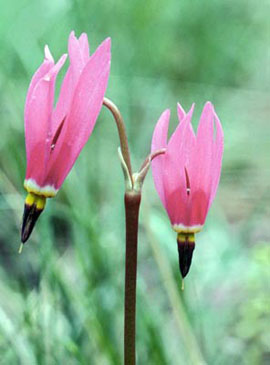
Dodecatheon hendersonii
This bulb-producing perennial begins in late winter with thick spoon shaped leaves at the base of the plant. Showy flowers appear in early spring on top of a tall 12 in (30 cm) leafless flower stalk. Flowers are inside out with petals magenta to deep lavender to white, with a white strip before the black fertile part. It blooms February to May and is summer deciduous, dying back to the ground after the rains cease.
- Light Requirements: Full Sun, Part Shade
- Water Requirements: Moist
- Ease of Growing: Easy to grow
- Growth Rate: Moderate
- Spreads:
- Wildlife Support: Pollinators, Pest-eating Insects
- Fire-resistant: No
- Edible:
- Mature Height: 1ft
- Mature Width:6in

